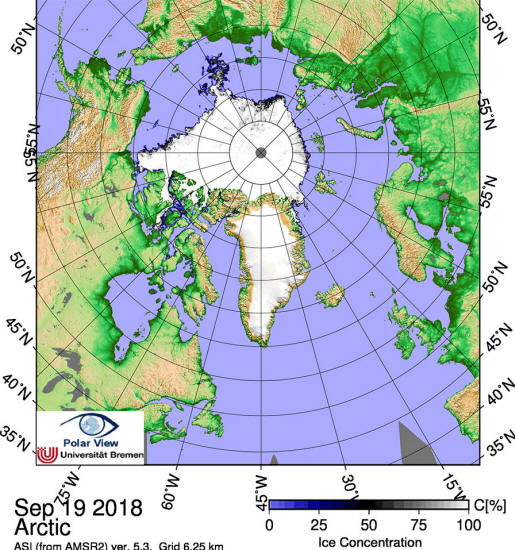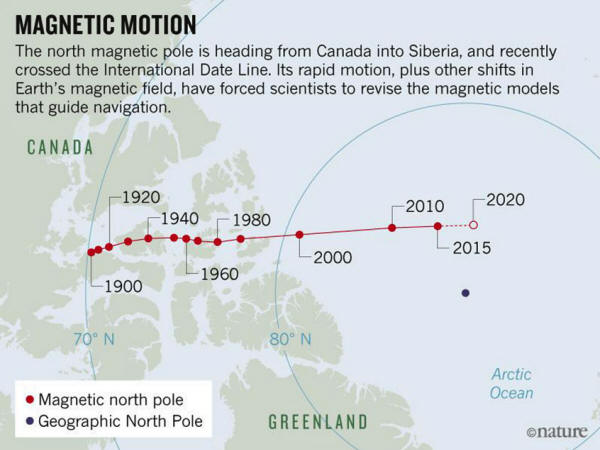|

by Alexandra Witze
January
09, 2019
from
Nature Website

Erratic motion
of north magnetic pole
forces experts
to update model
that aids global
navigation.
Update, 9
January:
The release of the World
Magnetic Model
has been postponed to 30
January
due to the
ongoing US government shutdown.
Something strange is going on at the top of the world.
Earth's north magnetic
pole has been skittering away from Canada and towards Siberia,
driven by liquid iron sloshing within the planet's core. The
magnetic pole is moving so quickly that it has forced the world's
geomagnetism experts into a rare move.
On 15 January, they are set to update the World Magnetic Model
(WMM),
which describes
the planet's magnetic field and
underlies all modern navigation, from the systems that steer ships
at sea to Google Maps on smartphones.
The most recent version of the model came out in 2015 and was
supposed to last until 2020 - but the magnetic field is changing so
rapidly that researchers have to fix the model now.
"The error is
increasing all the time," says Arnaud Chulliat, a geomagnetist
at the University of Colorado Boulder and the National Oceanic
and Atmospheric Administration's (NOAA's) National Centers for
Environmental Information.
The problem lies partly
with the moving pole and partly with other shifts deep within the
planet.
Liquid churning in
Earth's core generates most of the magnetic field, which varies over
time as the deep flows change. In 2016, for instance, part of the
magnetic field temporarily accelerated deep under northern South
America and the eastern Pacific Ocean.
Satellites such as the
European Space Agency's
Swarm mission tracked the shift.
By early 2018, the World Magnetic Model was in trouble. Researchers
from NOAA and the British Geological Survey in Edinburgh had been
doing their annual check of how well the model was capturing all the
variations in Earth's magnetic field.
They realized that it was
so inaccurate that it was about to exceed the acceptable limit for
navigational errors.
Wandering pole
"That was an
interesting situation we found ourselves in," says Chulliat.
"What's happening?"
The answer is twofold, he
reported last month at a meeting of the American Geophysical Union
in Washington DC.
- First, that
2016 geomagnetic pulse beneath South America came at the worst
possible time, just after the 2015 update to the World Magnetic
Model.
This meant that the
magnetic field had lurched just after the latest update, in ways
that planners had not anticipated.

Source: World Data Center for Geomagnetism
Kyoto Univ.
- Second, the motion of the north magnetic pole made the
problem worse.
The pole wanders in
unpredictable ways that have fascinated explorers and scientists
since
James Clark Ross first measured
it in 1831 in the Canadian Arctic.
In the mid-1990s it
picked up speed, from around 15 kilometers per year to around 55
kilometers per year.
By 2001, it had entered
the Arctic Ocean - where, in 2007, a team including Arnaud
Chulliat landed an aeroplane on the sea ice in an attempt to
locate the pole.
In 2018, the pole crossed the
International Date Line into the
Eastern Hemisphere. It is currently making a beeline for Siberia.
The geometry of Earth's magnetic field magnifies the model's errors
in places where the field is changing quickly, such as the North
Pole.
"The fact that the
pole is going fast makes this region more prone to large
errors," says Chulliat.
To fix the World Magnetic
Model, he and his colleagues fed it three years of recent data,
which included the 2016 geomagnetic pulse.
The new version should
remain accurate, he says, until the next regularly scheduled update
in 2020.
Core questions
In the meantime, scientists are working to understand why the
magnetic field is changing so dramatically.
Geomagnetic pulses, like
the one that happened in 2016, might be traced back to 'hydromagnetic'
waves arising from deep in the core. 1 And the fast
motion of the north magnetic pole could be linked to a high-speed
jet of liquid iron beneath Canada. 2
The jet seems to be smearing out and weakening the magnetic field
beneath Canada, Phil Livermore, a geomagnetist at the
University of Leeds, UK, said at the American Geophysical Union
meeting.
And that means that
Canada is essentially losing a magnetic tug-of-war with Siberia.
"The location of the
north magnetic pole appears to be governed by two large-scale
patches of magnetic field, one beneath Canada and one beneath
Siberia," Livermore says.
"The Siberian patch
is winning the competition."
Which means that the
world's geomagnetists will have a lot to keep them busy for the
foreseeable future.
References
-
Geomagnetic acceleration and rapid
hydromagnetic wave dynamics in advanced numerical
simulations of the geodynamo - Aubert, J. Geophys.
J. Int. 214, 531–547 (2018)
-
An accelerating high-latitude jet in
Earth's core - Livermore, P. W., Hollerbach, R. &
Finlay, C. C. Nature Geosci. 10, 62–68 (2017)
| 


